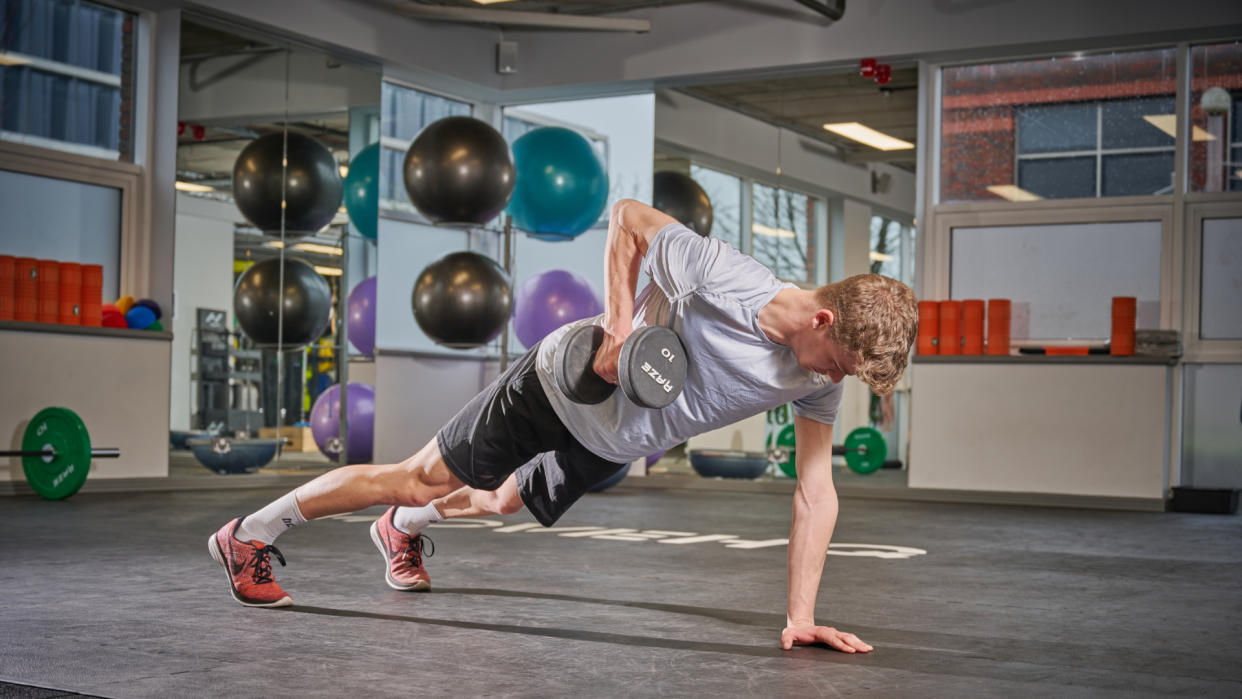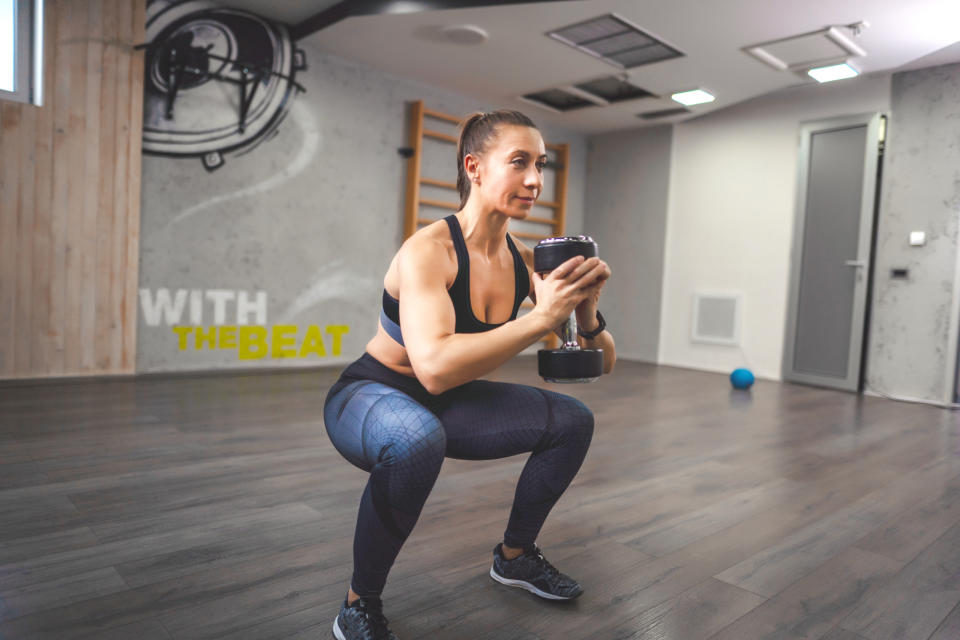Six strength-boosting dumbbell exercises for cyclists - make the most of this home-gym staple

The benefits of strength training for cyclists is well documented, although many cyclist still don’t include it in their training regime. This may be because they are unsure on how to do it or think it will effect their training on the bike.
As we get older we lose muscle mass and strength, termed sarcopenia. Muscle mass decreases by 3-8 per cent per decade after the age of 30. Furthermore, we get a greater decline is fast-twitch (Type II) fibres, hence the need for strength training to prevent a decline in performance. This is particularly relevant for masters athletes and women. especially those approaching menopause.
Even if performance is not your top priority, it’s positive effects on injury prevention, bone density and body composition make it more than worthwhile.
Benefits of strength training
There is a vast amount of research evidence showing that traditional strength training (i.e. resistance training with weights) improves cycling performance. These benefits include increasing peak power, anaerobic threshold power, time trial performance, muscular strength, fractional utilisation of VO2 max and improving cycling economy. This means that you will be able to sustain a higher power at a certain VO2 value.
Stronger cyclists will be more robust, and less likely to suffer from an injury. Resistance training is reported to reduce the risk of overuse injuries by 50 per cent, which are common in cycling.
Cycling is a non-weight bearing activity and will not stimulate bone growth due to the lack of impact on the skeletal system. This is the primary reason cyclists are prone to low bone density.
Combined with the risk of under-fuelling due to the large amount of energy expended in cycling and/or insufficient energy intake (intentional or unintentional), means you have the perfect recipe for a decline in bone mass. Furthermore low bone density increases the risk for fractures in a sport with a high risk of falling/crashing. Lifting weights can help mitigate this process. When muscles contract, they exert force on your bones, creating a mechanical stress. This stress stimulates the bone cells to remodel and become stronger.
Finally, strength training has a favourable effect on body composition, increasing muscle mass, decreasing body fat and increasing resting metabolic rate.
What strength training should I be doing as a cyclist?
Strength training should be specific and functional, matching the movements and positions of cycling. It should target the major power produces of the lower body, but also include upper body work to help prevent fatigue in the arms and core (and improve sprinting power).
Single leg exercises should be incorporated as cycling is essentially a single leg sport. Single leg exercises require more co-ordination, core and pelvic stability, and will quickly reveal any differences in leg strength that need to be addressed.
A cyclist’s strength training program is different than a bodybuilder’s and should avoid lifting to failure with high repetitions. The weight should be moderately heavy, one where fatigue is achieved within 4-12 repetitions. The number of repetitions and sets can vary from 4-10 reps and 2-5 sets, depending on the load.
The number of sessions per week can vary according to the time of year. During off-season or base phase, aim for 2 to 3 strength workouts per week working with higher loads to increase force production and maximal strength. During build phase and race season, shift your strength focus towards maintenance with just one or two workouts a week.
The best dumbbell exercises for cyclists
Dumbbell exercises are essentially body weight exercises with added resistance, and hence can be performed easily at home without the need to attend a gym. All you need is a set of dumbbells (preferably a few different weight options) and an exercise mat. For those with no or little history of strength training behind them, dumbbell exercise will be sufficient to stimulate strength changes.
The exercises below form a good basis for cycling-specific strength training, but there are far more options! If you are new to strength training or have a history of injury, it is best to seek professional guidance from a Physiotherapist, Exercise Physiologist or Personal trainer. Ensure you can perform the exercise with good form before adding weights.
1. Squat

Squats and dead lifts should be your two staple lower limb exercises - squatting being more knee (quads) dominant, dead-lifting more hip (glut) dominant. They can (and should) also both be done as single leg exercises, which will demand much more stability of the foot and hip/pelvis, and require lower weights.
Stand with feet slightly more than shoulder width apart and hold either one dumbbell in front of your body, or two dumbbells to the side in either hand. Start the squat by moving your bottom backwards, bending at your hips and knees to thighs parallel, keeping your knees in line with your 2nd toe. Push back up to standing. Placing a chair or box behind will help with correct patterning as well as confidence that you won’t fall backwards!
2. Dead lift

Dead lifts particularly target the posterior chain (gluts, hamstrings, back extensors). Stand with dumbbells in front of your thighs, feet shoulder width apart. Move your bottom backwards and hinge at your hips, keeping the lower back straight throughout, allowing the knees to bend slightly.
Keep the weights close to your body and lower as far as you can with a straight back (often limited by hamstrings flexibility). Hinge back through your hips to return to the starting position.
3. Bulgarian split squat
A good exercise to load one leg but requiring less stability than pure single leg exercises. Place your back leg on a chair or box, holding dumbbells by your side. Bend front knee to 90 degrees, keeping the knee in line with the 2nd toe. Push back up through your front foot back to the starting position.
4. Bent over row
An upper body pulling exercise done in the cycling lean forward position, working both upper limb and isometric back extensor strength. Hinge forward until your trunk is roughly parallel to the floor (or less if you have limited flexibility), holding a dumbbell in each hand. Pull the dumbbells towards your body until the elbows are just past the midline and then slowly lower the dumbbells back to the starting position under control.
5. Push up + renegade row

This is an all-in-one upper body pushing, pulling and core exercise! Start in a high plank position with hands on two dumbbells. Lower your chest down to the floor then push yourself back up to complete a push up. Then, keeping your back straight and hips level, pull the right dumbbell up to the right ribs, then back to the floor. Repeat with the left dumbbell. This is one rep. The exercise can also be done on your knees for less difficulty.
6. Side plank rotations
This exercises works on your lateral trunk and hip stabiliser strength, obliques and shoulder stabilisers. Place your shoulder directly over your elbow on one side, stack your feet, and lift your hips up off the ground. Hold a light dumbbell in your free hand and reach up to the ceiling. Rotate your trunk to reach under your body then return to starting position. Can also be done on your knees or without a weight.

